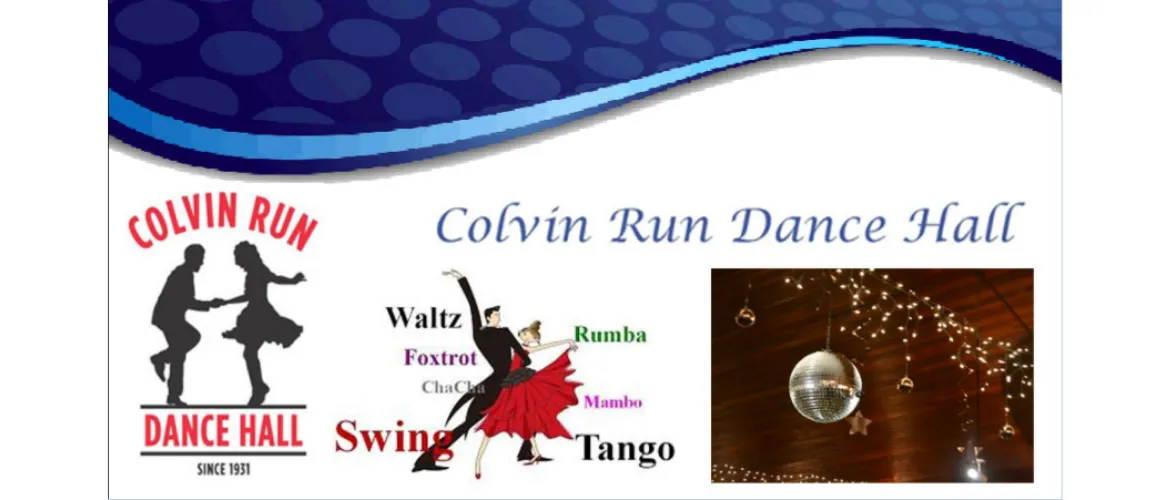Learn About the Colvin Run Citizens Association
In 1931 a group of local citizens, under the leadership of Joe Wheeler, formed Colvin Run Citizens Association, Inc., to purchase an abandoned schoolhouse property and establish a community center.
During these early days of The Great Depression, Mr. Wheeler and four of his “Citizens Association” neighbors chose to focus upon their community. They were fortunate to have the means to do so. It was their intent to establish a nonprofit, volunteer organization “dedicated to the promotion and betterment of social conditions, charitable and eleemosynary works, and, in general, the promotion of general civic, social and moral welfare for the betterment of the local community.”
For over eighty years, the community center that Mr. Wheeler and friends created has been a venue for community activity and social dancing. Throughout its history, Colvin Run Citizens Association has been dedicated to providing services beneficial to the public interest, all without compensation to its officers or directors. The Association has continuously used its facilities to educate the general public in social dance and has provided its facilities to the general public for dance workshops, dance instruction, social and recreational activities, and the arts in general.
Colvin Run Citizens Association Board of Directors
Great Falls | Colvin Run Dance Hall | 703-759-2685
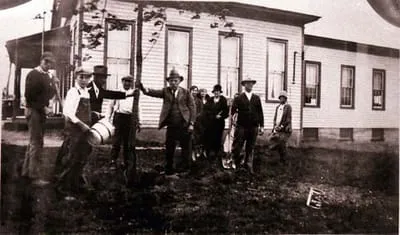
Colvin Run Tree Planting Ceremony 1932. Pictured left to right, James Bradford, Kenneth Roberts, James Coulter, Mr. Roberts, William Cockrill, Myrtle Crippen, Collette Trickett, Mrs. Jim Coulter, Mrs. Grant Trickett, Joe Wheeler, Josie Oliver. (Photo courtesy of Fairfax County Park Authority)
Click to view articles below.
1. The History of Colvin Run Community Center by Walter O. Harrison
2. The Colvin Run School History by Marty Nelson
3. Colvin Run School by Debbie Robison
4. The History of the Syncopators by Stanley Manvell
History of the Colvin Run Community Center
By Walter O. Harrison
According to Great Falls historical records the Colvin Run School was built in 1885. This school burned and a new school was built in 1908. After being used as a school for many years, the Colvin Run Community League used the building for meetings. Following their meetings they had ice cream and cake served by Mr. And Mrs. Robert’s General Store, now known far and wide as Thelma’s Ice Cream Store.
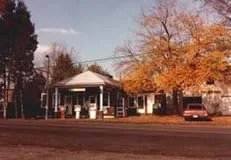
(Photo courtesy of Great Falls Historical Society) |
The narrow road between Thelma’s ice cream store and the Colvin Run Schoolhouse was Route 7 until 1943 when a major widening and re-routing of the Alexandria Turnpike took place and was renamed Leesburg Pike and what had been a portion of Route 7 was named Colvin Run Road. In 1931, a group of local citizens under the leadership of Joe Wheeler formed Colvin Run Citizens Association and purchased the schoolhouse property from the Fairfax County School Board to establish a community center.

Joe Wheeler 1931 First CRCA President (Photo CRCA Archives) |
Since that time, Colvin Run Citizens Association has remained a non-profit, tax exempt, volunteer organization dedicated to the preservation and upkeep of the historical Colvin Run Schoolhouse and to provide monthly donations to charitable, health and educational organizations. Under the by-laws of the Association, recreational and educational activities in the schoolhouse are held to raise the necessary funds towards these goals. Dances held on the first, third and fifth Saturday nights from September until June, with a special dance on New Year’s Eve, provides the income to meet our expenses. Donations are regularly made to one or two different charities each month with occasional donations to good causes. The bell is still in the tower and is rung annually on New Year’s Eve.
Prior to the acquisition of the Colvin Run schoolhouse, dances were held in Joe Wheeler’s barn on Hunter Mill Road. Mr. Wheeler did not charge for use of the barn so that money could be collected for the purchase of the school house and for the large dance floor addition that was completed in 1932.
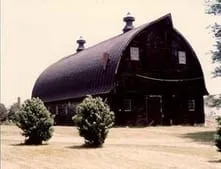
Joe Wheeler's barn as it appeared in 1983. (Photo CRCA Archives) |
Mrs. Leitha Hurst’s band played at the barn and later at the school house. The Vienna Syncopators Orchestra that consisted of a number of Manvell brothers and others also played at Colvin Run occasionally until 1942 when, because of World War II, the orchestra was dissolved. After the war George and Stanley Manvell joined Mrs. Hurst's band and were later joined by Joe Mason and Randy Latimer. After Mrs. Hurst's death in 1962, Bill Manvell played piano and the name Syncopators was revived. When ill health forced Bill to give up playing with the band, Mrs. Hurst’s daughter, Louise, played piano until her death. There have been a number of changes in the band members over the years. Joe mason died, Randy Latimer retired, and George Manvell died. Kenny Gorham joined the band and played trumpet. When Stanley Manvell retired he retired the Syncopators name and Kenny Gorham took over leadership and renamed the band the Colvin Run Jazz Band. Kenny had to quit playing in 1998 because of damage to his upper lip, the result of so many years of blowing the trumpet. Gary Buckley sat in with the band when he was in high school and later played with the Navy Commodores. After he finished his tour of duty he joined the Colvin Run band on a regular basis and after Kenny Gorham retired Gary led the Colvin Run dance band until 2004.
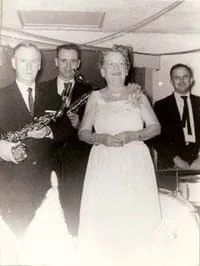
1940 – Leitha Hurst Band, pictured left to right, Joe Mason, Stanley Manvell, Letha Hurst, Dick Latimer (Photo CRCA Archives) |
The bands at Colvin Run under various leaders have always, in a similar style, played many of the old favorite dance tunes of the 40s, 50,s plus popular tunes of later years and many Latin numbers. In June 2004, the end of the regular dance season, Gary retired from being the band leader. Jim Houck after playing bass with Gary last year agreed to take over the leading of the Colvin Run dance band. In 2005 Bill Van Lear assumed leadership of the Colvin Run dance band. Al Buckmaster continued to play drums and various new members have filled in on piano, sax, trumpet, etc. Roger Rossi, trumpet and Don Lerman, saxophone and clarinet, are favorite additional band members. This band and the dances held here at Colvin Run School are for many of us a very important and pleasant link to our past. There are not many things today that are as they were in the 40s & 50s--but Colvin Run dances are almost the same with a few innovations. In the early years there were no tables, only chairs around the edge of the dance floor, and smoking was permitted in the building. Now we smoke outside while we sit at tables and have our refreshments. In 2007 we celebrated 75 years of dancing at Colvin Run.
The Colvin Run School History
By Marty Nelson
The one acre of land now housing the Colvin Run School house was deeded to Alfred Leigh, George Gunnel and John Barnes, Trustees, Fairfax County Board of Education, by James T. and Alma Mateer on April 3, 1884 for the sum of fifty five dollars. According to Great Fails historical records, the school was built within the next year.
Our oldest data on record from 1925 indicates the organized group was then called the Colvin Run Community League, a co-op with branches throughout the Commonwealth of Virginia. Their purpose was to assist one another in helpful techniques of dairy farming and the raising and harvesting of crops and in improving the welfare and well being of the residents in surrounding communities. The schoolhouse was used for the Community League meetings. Following these meetings ice cream and cake would be served at Mr. and Mrs. W.B. Roberts’ general store across the street. The League members worked cooperatively with the school staff in providing the students with many items of need, including books, gifts for the children during holidays throughout the year, and coal for the pot bellied stove.
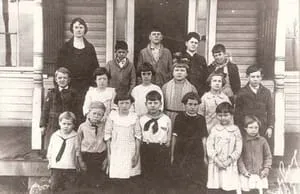
Colvin Run School picture dated 1923 – Pictured left to right, back row, Viola Thompson Kidwell (Teacher), George Higby, George Youngblood, Bruce Tricket, Donald Fortny. Middle row, Clarence Millard, Etta Bradford, Edna Duncan, Helen Wyckocp, Margaret Tracy, Leroy Duke, Front row, Kenneth Robers, Wilton Ballenger, Ethe Bradford, Carroll Wheeler, Loraine Roberts, Lucile Sanders, Anna Fortney. |
Prior to 1931, the year Colvin Run School was purchased from Fairfax County for $2,600 at public auction, the Board of Education determined the school was no longer needed for educational purposes. The prime factor for closing the school was lack of enrollment. The children were then bused to Forestville School located at Georgetown Pike. The name Forestville was later changed to Great Falls, Virginia to avoid confusion with Forestville, Maryland. Mr. Marion Money was the first bus driver for this route, and is a life member of the Colvin Run Citizens Association.
Also prior to requisition of the schoolhouse and before the addition of the hall was completed (by 1932) the local dances were held in Joe Wheeler’s magnificent horse barn on his farm, Huntmere, on Hunter Mill Road. The surrounding countryside was most ideal for horse shows and other community activities. The dances were held on Wednesday and Saturday nights.
Arthur Godfrey of radio and television fame was a member of the association and would announce the dates of the dances at Colvin Run during his radio program, which was broadcast from Alexandria, Virginia. Mrs. Leitha Hurst’s band played at the barn and later at the school house. Mr. Wheeler, long known as the inspirational community leader, did not charge for use of the barn. This helped the group in their efforts to obtain money to purchase the schoolhouse.
A deed of trust was placed on the schoolhouse in the amount of $2400 to help defray the purchase price and the cost of the addition of the hail. Thirteen promissory notes at the interest rate of 6% per annum, payable semi annually for five years were executed. The deed of release was executed in November 1936. Among the thirteen members who loaned the money in amounts of $200 and $100 were Leonard Brown. James Coulter. J.L Signor, Charles A. Millard, H.L. Cunningham, James Thompson, Howard Slack, William Slack, C.C. Fling, Thomas Pearson, Joseph A. Wheeler, Al. Kidwell and F.H Kidwell.
It is well documented that during the 1920s and 1930s Colvin Run and the surrounding communities was a distressed area. The roads were in deplorable condition for years. At that time the farmers would repair the damage caused by washouts with logs. They were then allowed to deduct this cost from their taxes. It is interesting to note that Route 7 was then called the Alexandria Turnpike because it was the main route south, over which farmers would haul their harvests of crops and grain to the port of Alexandria, Virginia. By 1940 surveying started for the purpose of straightening and leveling the pike to make it a safer road to travel. In 1943 the road opened; consequently the new road bypassed Colvin Run completely.
When the dances were first held in the schoolhouse, benches were placed around the hall for people to sit on. Overstuffed furniture was used in the section next to the area now used for the cloakroom and positioned around a coal stove. The original school bell has been kept up in operating condition and is rung every New Years Eve. The Colvin Run Citizens Association has continued to function as a civic and social organization for over 75 years.
The History of the Syncopators
By Stanley Manvell
The history of the Syncopators Orchestra really begins in the early 1900's when Arthur and Harry Manvell came to Washington from London, England, and established themselves in the music business. By 1920 Arthur was the conductor of the orchestra at the Strand Theater at 9th and D streets. Harry played the piano in that orchestra.
In 1922 Bill Manvell came to Washington and obtained work playing piano for the silent movies. He later became pianist in the orchestra at a Burlesque theater, and still later, he became the youngest orchestra leader in the Mutual Burlesque Circuit of 39 theaters throughout the country.
To finish the family picture, our father came here the same time as Bill. Our mother and I, Stanly Manvell, came in 1923. Our brother George and his family and our sister Nance and her husband, Charlie Scott, arrived the next year.
In 1926 I joined Bill's orchestra at the Burlesque Theater playing bass parts on the bass saxophone. The following year I changed to tenor sax and have stayed with it ever since. During the summer, when the theater was dark, we played for dancing at the Marshall Hall Amusement Park, riding up and down the river on the old paddle-steamer "Charles McAlister".
This was a very pleasant period, but there was a big, bad, bogey-man on the horizon. That bogey-man was the talking pictures. This new branch of show business was eventually to wipe out the Burlesque and Vaudeville branches of entertainment, and with it, the employment of theater musicians. The Manvells were no exception to the rule and lost their jobs together with about a thousand other fully competent musicians. They had to pay the price for progress.
The Manvells lived in the town of Vienna, which, at that time had a population of less than 1,000 people. It was the sort of place where you got yesterday's news in today's paper and it would not come out until tomorrow. However, it was a very friendly place where everyone knew everybody else.
It wasn't very long before the members of the family began providing music for local functions, most of them concert type affairs, but there were also some dances. No charge was made for any of these performances.
It came to be that the Manvells were playing for quite a lot of these local dances. Soon they began to receive requests to play at other places, and so the Syncopators Orchestra was born. This was during the 1930's and early 1940's. They played a kind of "not too loud" music, that was easy to dance to, and our slogan was "Happy music for happy feet". We eventually grew into an eight piece orchestra which was to survive for many years. The eight pieces included Bill on piano, Howard King on drums, Bill Harkness on banjo and sax, Horace Masters on Banjo, brother George on violin, his son George on sax and me on sax. Charlie Scott was also a member of the original group playing violin and sax. Dee Crickenberger acted as emcee, announcer, and also sang. His version of "Old Man Mose" was a real classic. Ronny Jackson played string bass for a short period and we also enjoyed the singing of Irene Manvell and Francis King.
During that time, the Syncopators played for two years at Goose Creek Tavern, two years at Aquia Tavern, and for a long time at Colvin Run. This was the period when the dances at Colvin Run were run by Joe Wheeler, and the refreshment counter was tended by Mrs. Oliver and Mrs. Balenger. The counter was later taken over by Ruth Kidwell. Colvin Run was quite popular with students from Herndon High School, and we played for several proms at that school. Also, this was the time when volunteer fire departments held carnivals every year to raise money. The Syncopators played for many of these carnivals. There are many old-timers around now who remember dancing to the Syncopators at these carnivals.
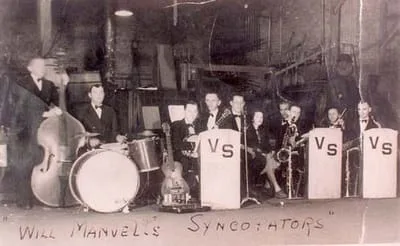
1938 WILL MANVELL'S VIENNA SYNCOPATORS -- Pictured left to right: Ronny Jackson, Howard King, Bill Harkness, William Manvell, Dee Chrickenbeger, Frances King (vocalist), Charles Scott, George Manvell, George Manvell Sr., Stanley Manvell. (Photo CRCA Archives) |
We also played quite a lot in the region of Stafford, having the dubious pleasure of driving there in snow and ice. There was one time when we drove in such a heavy fog that it was impossible to see the road. The only way we got there was to follow closely behind a Trailways bus, stopping and starting with the bus. We also played at the old Aquia Church. It was in the dead of winter and there was absolutely no heat in the hall. We played in our overcoats, and between groups, warmed our hands at a small pot-bellied stove in an adjoining room. We nick-named that place "Refrigerator Hall". We also played as far away as Fairview Beach and at an inn in Cumberland. It was not unusual for the Syncopators to playas many as five times in one week.

1940 – Leitha Hurst Band, pictured left to right, Joe Mason, Stanley Manvell, Letha Hurst, Dick Latimer (Photo CRCA Archives) |
It was during this time that Mrs. Hurst's band was very popular. There was one period when she played at Colvin Run on Saturdays and the Syncopators played there on Wednesdays.
The Syncopators orchestra was finally dissolved in 1942 when the pressure of wartime work took precedence over music. After the war, when George returned home from Europe, he started playing with Mrs. Hurst's Band. After awhile I, too, joined them on a part time basis. I played the Friday jobs and the regular sax player played the Saturday jobs. Then George moved to Florida and I took his place full time.
Shortly after that, the regular sax player left the band and Joe Mason took his place. Our drummer at that time was Dave Glassman, and the four of us, Mrs. Hurst, Dave, Joe and I stayed together for several years until Dave had to quit for personal reasons. Dick Latimer then became our drummer. Dick was a D.C. policeman, and when he was promoted to Desk Sergeant and put on night work his place in the band was taken over by his brother Randy Latimer. Mrs. Hurst's band played at Colvin Run, the Oddfellow's Hall in Falls Church, and the Great Falls Fire Department on a regular basis with many single engagements fitted in between.
It was a sad day when Mrs. Hurst passed away on May 21, 1962. It looked as though this would be the end of the band, but Bill came to the rescue and we continued as usual until September 1971 when ill health forced Bill to leave. The name "Syncopators" was revived when Bill started playing after the death of Mrs. Hurst.
After Bill left, Louise, Mrs. Hurst's daughter, came into the picture and is still playing. At various times during these years we had three players, Frank Moran, Earl Moffett, and Carl Dresher. We also enjoyed the singing of Ted Visnic.
We had one more sad occasion when we lost Joe Mason, but we were fortunate enough to have Gary Buckley to help us out. Gary used to sit in with us when he was in high school and was, and is, thoroughly familiar with our type of music. Then Kenny Gorham joined us with his trumpet and that brings us up to date.
Through the years, all of our dances have been happy ones and we have made many highly valued friends. We hope that when old man time catches up with some of us, as he must do, that somehow, the orchestra will, in some way, survive and carry on the tradition of good music.
We are in search of old photographs and memorabilia of events held at the schoolhouse from 1885 to 1990. Please contact Jean Rosenbluth at 703-620-0366 if you have anything that would be of interest
.
